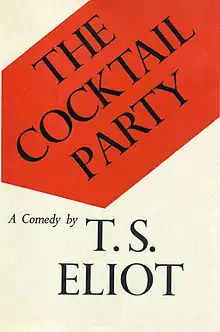The Cocktail Party
The Cocktail Party is a play by T. S. Eliot. Elements of the play are based on Alcestis, by the Ancient Greek playwright Euripides. The play was the most popular of Eliot's seven plays in his lifetime, although his 1935 play, Murder in the Cathedral, is better remembered today. It was written while Eliot was a visiting scholar at the Institute for Advanced Study in Princeton, New Jersey in 1948.[1]
| The Cocktail Party | |
|---|---|
 First edition (Faber & Faber) | |
| Written by | T. S. Eliot |
| Characters | Edward Chamberlayne Lavinia Chamberlayne Celia Coplestone Sir Henry Harcourt-Reilly Miss Barraway Peter Quilpe Julia Shuttlethwaite Alexander MacColgie Gibbs |
| Date premiered | Edinburgh: 22 August 1949 Broadway: 21 January 1950 |
| Place premiered | Edinburgh Festival Edinburgh, Scotland Broadway: Henry Miller's Theatre New York City, New York |
| Original language | English |
| Setting | London, England |
- For the novella and play by Okinawan writer Ōshiro Tatsuhiro, see The Cocktail Party.
The Cocktail Party was first performed at the Edinburgh Festival in 1949. In 1950 the play had successful runs in London and New York theaters (the Broadway production received the 1950 Tony Award for Best Play.) It focuses on a troubled married couple who, through the intervention of a mysterious stranger, settle their problems and move on with their lives. The play starts out seeming to be a light satire of the traditional British drawing room comedy. As it progresses, however, the work becomes a darker philosophical treatment of human relations. As in many of Eliot's works, the play uses absurdist elements to expose the isolation of the human condition. In another recurring theme of Eliot's plays, the Christian martyrdom of the mistress character is seen as a sacrifice that permits the predominantly secular life of the community to continue.
In 1951, in the first Theodore Spencer Memorial Lecture at Harvard University Eliot criticised his own plays in the second half of the lecture, explicitly the plays Murder in the Cathedral, The Family Reunion, and The Cocktail Party. The lecture was published as "Poetry and Drama" and later included in Eliot's 1957 collection On Poetry and Poets.
Synopsis
Edward and Lavinia Chamberlayne are separated after five years of marriage. She has left Edward just as they are about to host a cocktail party at their London home, and he has to come up with an explanation for why Lavinia is not present, in order to keep up social appearances. Lavinia is brought back by a mysterious Unidentified Guest at the party, who turns out to be a psychiatrist whom Edward and Lavinia both consult. They each learn that they have been deceiving themselves and must face life's realities. They learn that their life together, though hollow and superficial, is preferable to life apart. This message is difficult for the play's third main character, Edward's mistress, to accept. She, with the psychiatrist's urging, also moves on towards a life of greater honesty and salvation and becomes a Christian martyr in Africa. Two years later, Edward and Lavinia, now better adjusted, host another cocktail party.
Characters
- Edward Chamberlayne
- Lavinia Chamberlayne
- Celia Coplestone, Edward's mistress
- Sir Henry Harcourt-Reilly, the mysterious stranger/psychiatrist
- Miss Barraway, Sir Henry's secretary
- The couple's friends:
- Peter Quilpe, with whom Lavinia has an affair, but who yearns for Celia
- Julia Shuttlethwaite
- Alexander MacColgie Gibbs
Productions
After its debut at the Edinburgh Festival in 1949 with Alec Guinness in the role of the unidentified guest, produced by Henry Sherek and directed by E. Martin Browne,[2] The Cocktail Party premiered on Broadway on 21 January 1950 at the Henry Miller's Theatre and ran for 409 performances. Produced by Gilbert Miller[3][4] and directed by E. Martin Browne, the production starred Guinness as the mysterious stranger. It received the 1950 Tony Award for Best Play.[4] The play also ran in London with Rex Harrison as the uninvited guest.
A revival opened on 7 October 1968 at the Lyceum Theatre and ran for 44 performances. The Chamberlaynes were played by Brian Bedford and Frances Sternhagen, with Sydney Walker as the mysterious stranger.
Guinness returned to the role of the uninvited guest at the Chichester Festival Theatre under his own direction in 1968, taking the production to London later in the year.
In the spring of 2010, the New York-based Off-Broadway company The Actors Company Theatre (TACT) presented the play.
References
- Institute For Advanced Study Frees Scholar From Class, Tests, Students The Harvard Crimson, November 7, 1953
- Darlington, W. A. (2004). "Henry Sherek". Oxford Dictionary of National Biography. Oxford University Press. Retrieved 27 July 2014.
- "New Plays in Manhattan". Time. 30 January 1950. Retrieved 2008-06-15.
- "Search Past Tony Award Winners (Gilbert Miller)". Tony Awards. Archived from the original on 22 September 2015.
Further reading
- T. S. Eliot, The Complete Poems and Plays
- Grover Smith, T.S. Eliot's Poetry and Plays: A Study in Sources and Meaning
- E. Martin Browne, The Making of T.S. Eliot's Plays.
External links
| Wikiquote has quotations related to: The Cocktail Party |
- The Cocktail Party at Faded Page (Canada)
- The Cocktail Party at the Internet Broadway Database
- The T.S. Eliot Page
